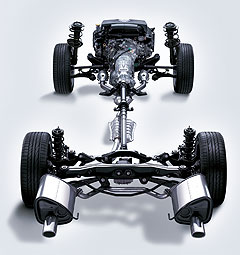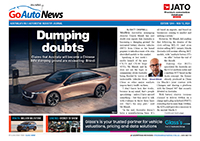Make / Model Search
News - SubaruSubaru gets boxed inAll-wheel dive: Achieving certain fuel efficiency goals with both AWD and boxer engines could be a problem for Subaru. The green movement places Subaru Australia’s core brand message under threat16 Nov 2007 By JAMES STANFORD and TERRY MARTIN SUBARU Australia’s two central brand pillars – the boxer engine and all-wheel drive – are under threat. The aspiring prestige marque has promoted the core technologies as fundamental elements for all models sold in Australia, refusing to take smaller inline engines and front-drive models available overseas. This policy has seen the image of Subaru rescued from a rudimentary budget outfit in the 1980s to a unique Japanese premium brand. Australian Subaru dealership signs even incorporate ‘all-wheel drive’ under the logo to make the point. Now, Subaru Australia managing director Nick Senior has revealed to GoAuto that ever-tightening emission standards and a desire to cut fuel consumption could force it to reconsider its position on AWD and boxer engines. “Those core technologies are a key part of the brand,” Mr Senior told GoAuto. “That is not likely to change in the foreseeable future. “Where there will need to be discussion and debate internally is if we develop environmentally friendly technology like an electric car or hybrid car or whatever, that may not be true to our core technology. “We would have to sit down one day and discuss whether that fits into that strategy. If not, do we look at changing that?” Mr Senior was quick to emphasise that Subaru Australia was committed to AWD and boxer engines for now. “As we sit here today, there is nothing in our product portfolio or pipeline that is not all-wheel drive or has a non-boxer engine – (but) that may not be the case forever and a day,” he said. A switch to non-boxer and 2WD would represent a seismic shift in the importer’s position. Subaru Australia chairman Trevor Amery told GoAuto back in 2002, when he was managing director, that the company was fully committed to the AWD/boxer engine combination.  “Whilst I’m in charge of the company, we will not have front-wheel drive cars and we won’t have non-boxer engines either,” he said. When asked whether the time would come when Subaru would have to move away from that format, Mr Amery said he was confident the formula would stay in place until at least 2010. “One of the reasons we chose to become an all-wheel drive company only was so that we wouldn’t confuse people with our message – and these are some of the things that are going to stand us in good stead for some time,” he said. “The fact is, for a long, long time – as far as I can see – we will be the only all all-wheel drive car company and we’re so proud of our technology and our system and the benefits to the customer with our all-wheel drive, that we put it in all our cars, not just one.” Mr Senior pointed out that existing Subaru models would continue to run AWD and boxer engines, while a new smaller and more economical vehicle could be the one without one or both of the features. Achieving certain fuel efficiency goals with both AWD and boxer engines could be problematic for Subaru. The issue regarding AWD is simply to do with the weight of the extra driveline components, which can have a big impact on fuel consumption. The issue with flat boxer engines is that Subaru does not produce any smaller than 1.5 litres. In Japan, small and economical Subaru cars use a regular inline 660cc four-cylinder engine, which could be used as part of a future hybrid model instead of a boxer unit. Indeed, one non-boxer powerplant the manufacturer is working on has no cylinders at all. Subaru presented the G4e concept at last month’s Tokyo motor show, an all-electric vehicle that pointed to the future direction of the car-maker. The company told journalists that it aimed to produce an all-electric vehicle for the Japanese market by 2010 and wanted to lead the industry with electric technology. It is unlikely that an electric vehicle would make it to Australia in the short-term, but the move reveals Subaru is prepared to push forward with non-boxer powerplants. When it came to developing a diesel engine that will be available in Europe from early next year, the company went to great lengths to stick with a boxer. It also incorporated its AWD and a boxer engine with its experimental work on hybrids, as shown with the 2005 B5-TPH (turbo parallel hybrid) concept car. However, Subaru has now frozen its independent petrol-electric hybrid program and has agreed to utilise Toyota’s system in developing its own hybrid cars. (Toyota bought an 8.7 per cent stake in Subaru in 2005.) The company’s first hybrid is not expected to reach production until well after the first diesel engine arrives – now likely to be 2009 in Australia. Mr Senior said Subaru Australia, which is the third-largest Subaru market in the world behind Japan and the US, was keen on getting the oil-burner next year in its all-new Forester, but advised against betting on it. “That is a wish, in terms of odds it is probably less than 50:50,” he said. Mr Senior said the company would definitely have an Outback with a diesel in 2009 and maybe a diesel-powered Liberty if it felt there was sufficient demand. |
Click to shareSubaru articlesResearch Subaru Motor industry news |









Facebook Twitter Instagram